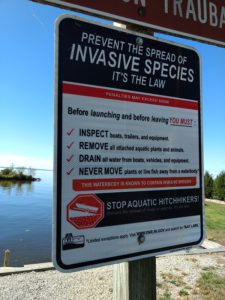Every month, we will put a spotlight on an aquatic invasive species (AIS) in a re-occurring monthly article. Check it out! This month, we highlight a threat to Wisconsin lakes: Viral Hemorrhagic Septicemia!
Viral Hemorrhagic Septicemia
Viral Hemorrhagic Septicemia (VHS) is a deadly fish virus that was confirmed in Lake Winnebago and Little Lake Butte des Morts in May 2007. VHS was first detected in the Great Lakes around 2005. The initial 2005 outbreaks within the Great Lakes killed thousands of fish and has a large host range of fish that have been infected. Infected fish species and die offs have included muskies, walleye, lake whitefish, freshwater drum, yellow perch, gizzard shad, redhorse, round gobies, Chinook salmon, white bass, emerald shiners, smallmouth bass, bluegill, black crappie, burbot, and northern pike. It is believed that the virus arrived either with migrating fish or in ballast water from the Atlantic coast.
Fish shed the virus into the water through urine and reproductive fluids. Transmission also occurs when fish eat infected dead fish. In severe infections, the virus infects gill tissues before moving into organ tissues and the blood. As the virus progresses, deadly internal hemorrhages in muscle, organ tissue, and skin develop due to weakened blood vessels. Other symptoms of VHS include bulging eyes, unusual behavior, anemia, and bloated abdomens. However, VHS must be confirmed by a lab test because these symptoms appear in other fish diseases.
The infection is most active in water temperatures between 37-54°F and becomes inactive above 59°F. The deadliest outbreaks occur when water temperatures are between 37-41°F. Because the virus needs cooler temperatures to live, it cannot survive in the bodies of warm blooded organisms. This is why fish-eating birds are not likely to spread VHS and why humans are not affected by it.
Infection does not always lead to death though. Infected fish can develop antibodies to VHS that will protect it from new infections. However, the concentration of antibodies drops over time, and the fish may start shedding the virus into the water again. The number of fish not exposed to the virus, and therefore without any antibodies, increases as time goes by without VHS outbreaks. This can lead to a cyclic pattern of large outbreaks.

Fish Kill. Photo Credit: Fox-11
Stressed fish are more susceptible to infection because stress suppresses immune response. Spawning hormones, poor water quality, lack of food, or excessive handling of fish all induce stress.
VHS has only been found in Wisconsin in Lakes Michigan, Superior, Green Bay, and the Winnebago Waterways.
In 2018, the Winnebago Waterways experienced a large fish die-off in late April. Hundreds of dead fish were reported that were mostly sheepshead but also included common carp, black crappie, yellow perch, bluegill, and largemouth bass. The WDNR did pathogen testing on over 60 fish and all were positive for VHS resulting in the WDNR concluding that the fish kill was due to VHS.
Want to help? HELP PREVENT THE SPREAD!
Every time you come off the water, make sure to follow these steps to stop the spread of faucet snails and other aquatic invasive species:
* Inspect boats, trailers, push poles, anchors, and other equipment for attached aquatic plants or animals.
* Remove all attached plants or animals
* Drain all water from boats, motors, livewells and other equipment
* Never move live fish away from a waterbody
* Never release aquarium plants or animals into your local waterways
Follow the Fox Wolf Watershed Alliance’s Winnebago Waterways Program on our Winnebago Waterways Facebook page or @WinnWaterways on Twitter! You can also sign-up for email updates at WinnebagoWaterways.org.
Questions? Comments? Contact Chris Acy, the AIS Coordinator for the Winnebago Waterways Program covering Fond du Lac, Calumet, and Winnebago Counties at (920) 460-3674 or chris@fwwa.org!
Winnebago Waterways is a Fox-Wolf Watershed Alliance program. The Fox-Wolf Watershed Alliance is an independent nonprofit organization that identifies and advocates effective policies and actions that protect, restore, and sustain water resources in the Fox-Wolf River Basin.
Photo Credit: Fox-11
